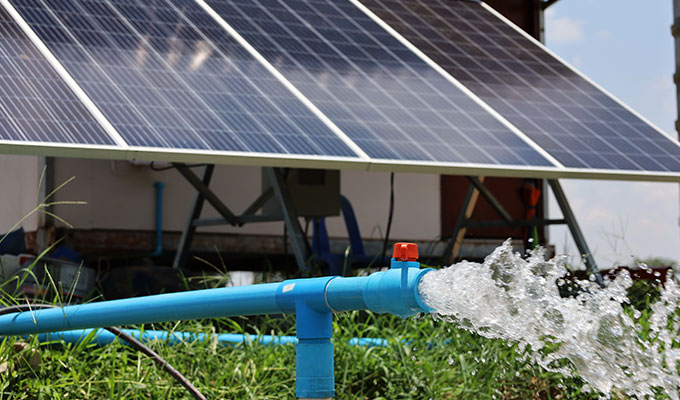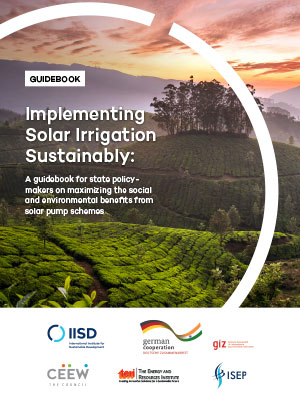Water-Energy-Food Nexus: Implementing Solar Irrigation Sustainably

The project aims to provide states with technical support on the implementation of PM KUSUM scheme across its three components. This comprises developing 10,000 MW of grid-connected solar power plants (component A), installation of 17.5 lakhs stand-alone solar pumps (component B) and solarizing 10 lakh grid connected agriculture pumps (component C).
A guidebook for the sustainable implementation of solar irrigation has been developed in the earlier phase of the project focusing on component B of the scheme, and another guidebook would be developed in the current phase emphasizing filling knowledge gaps pertaining to solarizing the agriculture feeder under component C. Findings from the research will serve to provide inputs to the MNRE for large-scale implementation of solar for irrigation.
Implementing Solar Irrigation Sustainably
Authors: Siddharth Goel, Rashmi Murali, Anas Rahman, Prajnashish Swain, Balasubramanian Viswanathan, Shalu Agrawal, Christopher Beaton, Mini Govindan, Abhishek Jain, Debajit Palit
The guidebook aims to support state policy-makers and agencies in India in sustainable implementation of solar irrigation, considering both social and environmental sustainability.
In 2019, India launched the PM-KUSUM scheme: a major initiative to promote solar-powered irrigation. Solarizing irrigation in India has huge potential. Cost-effective and reliable irrigation can significantly improve farmer's income and well-being. Furthermore, shifting away from subsidized grid electricity to solar power can greatly relieve the financial pressure that Indian utilities currently face while simultaneously help India shift to clean energy, reducing air pollution and greenhouse gas emissions.
However, given the complicated interconnections between water, energy and food— often called the "water–energy–food nexus" or WEF nexus— care must be taken to implement solar irrigation sustainably as interventions in one area of the nexus can cause unexpected impacts in another.
This guidebook provides concrete recommendations on how state officials can sustainably deploy standalone solar pumps. Developed in cooperation with the Ministry for New and Renewable Energy (MNRE), it aims to support state policy-makers and agencies in India in the sustainable implementation of solar irrigation, considering both social and environmental sustainability. The report works towards answering questions such as how can schemes maximize benefits for low-income farmers and how can schemes minimize risks of over-withdrawal of groundwater?
Based on an initial needs assessment, it considers these objectives over five major themes:
- Coordination: What inter-and intra-departmental coordination mechanisms are needed?
- Affordability and Financing: How to make pumps affordable within state financial constraints?
- Targeting: How to make sure the right-sized pumps go to the right beneficiaries and locations?
- Infrastructure: What infrastructure can boost farmer benefits and reduce groundwater risks?
- Monitoring and evaluation (M&E): What aspects of schemes should be monitored and evaluated?
This guidance is focused only on standalone and grid-connected pumps. It is intended to directly assist with implementing PM-KUSUM but also to be relevant for any solar irrigation scheme, including future policies once PM-KUSUM is completed. The report was developed by a consortium of organizations working in collaboration: the International Institute for Sustainable Development, The Energy and Resources Institute (TERI), the Council on Energy, Environment and Water (CEEW), and the Initiative for Sustainable Energy Policy (ISEP), supported by the Deutsche Gesellschaft für Internationale Zusammenarbeit (GIZ) GmbH.

